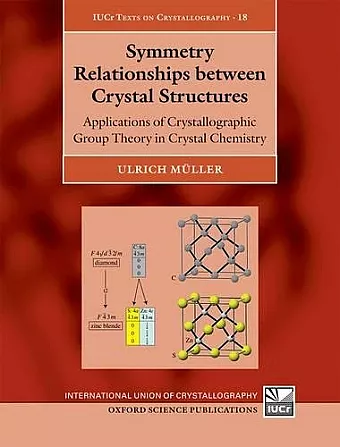Symmetry Relationships between Crystal Structures
Applications of Crystallographic Group Theory in Crystal Chemistry
Format:Hardback
Publisher:Oxford University Press
Published:4th Apr '13
Currently unavailable, and unfortunately no date known when it will be back
This hardback is available in another edition too:
- Paperback£43.99(9780198807209)

This book provides essential knowledge for organizing and understanding crystalline solid structures, focusing on crystallographic group theory and symmetry properties, with applications in crystal chemistry and numerous practical examples.
"Symmetry Relationships between Crystal Structures" provides a comprehensive introduction to the essential concepts required for understanding and organizing the extensive array of known crystalline solid structures. At its core lies crystallographic group theory, particularly focusing on the interplay between the symmetry properties of crystals. This foundational aspect is crucial in the fields of crystal chemistry and crystal physics, where the relationships among symmetry groups play a significant role.
The book is divided into two main parts. The first part lays out the necessary mathematical foundations and tools, emphasizing the fundamentals of crystallography and the theory of crystallographic groups. It covers the essential formalisms for conducting crystallographic computations, ensuring readers grasp the theoretical underpinnings before moving on to practical applications. This section is designed to equip readers with the skills needed to navigate the complexities of crystal structures.
In the second part, the book delves into the applications of crystallographic group theory in addressing various problems in crystal chemistry. Through numerous examples, it demonstrates how this theory can reveal connections between different crystal structures, facilitate systematic classification of known structures, predict new crystal formations, and analyze phase transitions and topotactic reactions. Additionally, it discusses the formation of domains and twins in crystals and provides guidance on avoiding common errors in structure determination. Each chapter concludes with a range of exercises, allowing readers to apply their knowledge, with solutions provided at the end for reference.
Here we have ... a rigorous, carefully checked and polished text which ... we have a reference text which, with its numerous examples and exercises, also perfectly fits the purpose of self-study, provided the reader is sufficiently familiar with space-group theory ... This is a book that every crystallographer taking seriously his job should have on his shelf. * Acta Crystallographica B *
Structural crystallographers in biology, chemistry and physics meet symmetry and sometimes relatively complicated cases. More can be made of symmetry relations too. This book takes the reader beyond structure. The book shows how to make use of the symmetry relations described in International Tables as well as understand e.g. crystal structure types, analyse phase transitions, domain formation and twinning in crystals as well as to avoid errors in crystal structure determinations such as choice of incorrect space group. Numerous chapter exercises are a distinctive feature and offer the possibility to apply the material that has been learnt; solutions to the exercises are at the end of the book. * John R. Helliwell, School of Chemistry, The University of Manchester *
ISBN: 9780199669950
Dimensions: 248mm x 200mm x 23mm
Weight: 946g
350 pages